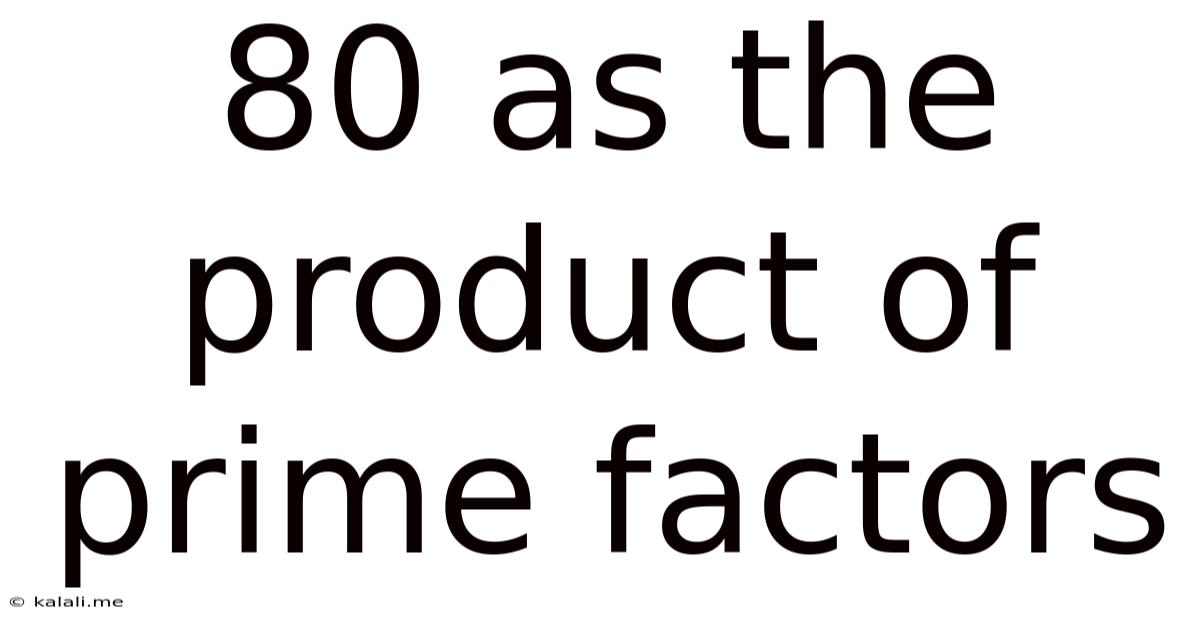80 As The Product Of Prime Factors
Kalali
Jun 11, 2025 · 3 min read

Table of Contents
80 as the Product of Prime Factors: A Comprehensive Guide
Finding the prime factorization of a number is a fundamental concept in number theory. This article will guide you through the process of determining the prime factors of 80, explaining the method and its significance. Understanding prime factorization helps in various mathematical operations, from simplifying fractions to solving algebraic equations. This guide will provide a clear and concise explanation, perfect for students and anyone looking to refresh their knowledge of prime numbers and factorization.
What are Prime Numbers and Prime Factorization?
A prime number is a whole number greater than 1 that has only two divisors: 1 and itself. Examples of prime numbers include 2, 3, 5, 7, 11, and so on. A number that is not prime is called a composite number.
Prime factorization is the process of expressing a composite number as a product of its prime factors. Every composite number can be uniquely expressed as a product of prime numbers, regardless of the order of the factors. This is known as the Fundamental Theorem of Arithmetic.
Finding the Prime Factors of 80
To find the prime factors of 80, we can use a method called the prime factorization tree. Here's how it works:
-
Start with the number 80.
-
Find the smallest prime number that divides 80. This is 2. Divide 80 by 2: 80 ÷ 2 = 40.
-
Repeat the process with 40. The smallest prime number that divides 40 is 2. 40 ÷ 2 = 20.
-
Continue with 20. Again, the smallest prime number that divides 20 is 2. 20 ÷ 2 = 10.
-
Continue with 10. The smallest prime number that divides 10 is 2. 10 ÷ 2 = 5.
-
The result is 5. 5 is a prime number, so we stop here.
Therefore, the prime factorization of 80 is 2 x 2 x 2 x 2 x 5, which can be written as 2<sup>4</sup> x 5.
Representing the Prime Factorization
We can represent the prime factorization of 80 in a few different ways:
- Expanded form: 2 x 2 x 2 x 2 x 5
- Exponential form: 2<sup>4</sup> x 5
- Factor tree diagram: A visual representation of the steps outlined above.
Applications of Prime Factorization
Understanding prime factorization is crucial for various mathematical operations, including:
- Simplifying fractions: Finding the greatest common divisor (GCD) of the numerator and denominator.
- Finding the least common multiple (LCM): Essential for adding and subtracting fractions with different denominators.
- Solving algebraic equations: Factoring polynomials often involves finding prime factors.
- Cryptography: Prime numbers play a crucial role in modern encryption techniques.
Conclusion
Finding the prime factorization of a number like 80 is a straightforward process once you understand the concept of prime numbers and the method of factorization. Mastering this skill provides a solid foundation for more advanced mathematical concepts and problem-solving. Remember, the prime factorization of 80 is 2<sup>4</sup> x 5, a fundamental piece of information in various mathematical applications.
Latest Posts
Latest Posts
-
How Old Is Someone Born In 1962
Jul 01, 2025
-
How Many Yards Are In 60 Feet
Jul 01, 2025
-
How Many Ears Of Corn To A Bushel
Jul 01, 2025
-
How Many Months Are In A Quarter
Jul 01, 2025
-
How Much Does A 12 Pack Of Pop Weigh
Jul 01, 2025
Related Post
Thank you for visiting our website which covers about 80 As The Product Of Prime Factors . We hope the information provided has been useful to you. Feel free to contact us if you have any questions or need further assistance. See you next time and don't miss to bookmark.